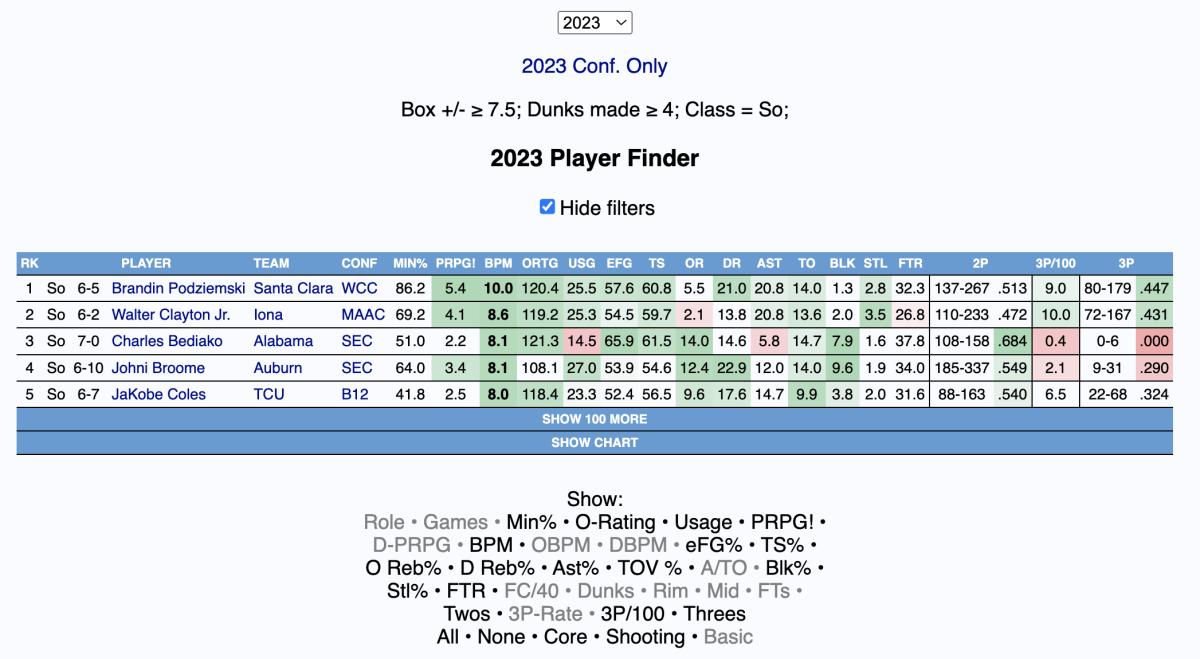NBA Draft: The Productive Young Athlete Query — Part Two

Last week, I discussed how 78% of college basketball players who hit the four criteria of the Productive Young Athlete query play five-plus years in the NBA (See article here).
The Productive Young Athlete query stated that 78% of freshmen college basketball players who play over 40% of their team's minutes, have a Box Plus-Minus of at least 7.5, and have at least four dunks throughout the season play five-plus years in the NBA.
So, I asked myself: What happens if you change the "freshman" component of my Productive Young Athlete query to "sophomore"?
The result is quite interesting, as there were 104 sophomores throughout the ten college seasons from 2010-2019 who played at least forty-percent of their team's minutes, had a Box Plus-Minus of at least 7.5, and met the minimum athletic threshold of four total dunks. Exactly 50% of them played five-plus years in the NBA or are currently in the NBA.
For the ease of reading, I'm defining "sticking" in the NBA as players who played five-plus years in the NBA or, if not applicable, are currently playing in the NBA. Let's also call this new query the Productive Sophomore Query (PSQ), as to not confuse the Productive Young Athlete (PYA) Query and our new one.
Prospects who met the Productive Sophomore Query and indeed did "stick" from 2010-2019:
2010: Draymond Green, Gordon Hayward, Greg Monroe, and Marcus Morris
2011: Kawhi Leonard, Khris Middleton, and Derrick Williams
2012: Dion Waiters, Jared Sullinger, Will Barton, Terrence Jones, and Andre Roberson
2013: Kentavious Caldwell-Pope, Otto Porter Jr, Cody Zeller, Spencer Dinwiddie, Trey Burke, and Michael Carter-Williams
2014: Marcus Smart, T.J. Warren, Kyle Anderson, Montrezl Harrell, Willie Cauley-Stein, Gary Harris, and Nik Stauskas
2015: Terry Rozier, Josh Hart, Bobby Portis, Kris Dunn, and Rondae Hollis-Jefferson
2016: Domantas Sabonis, Pascal Siakam, Jakob Poetl, and Grayson Allen
2017: Donovan Mitchell, Mikal Bridges, John Collins, and Brandon Clarke
2018: Robert Williams, Donte DiVincenzo, Landry Shamet, Udoka Azubuike, and Miles Bridges (who is included for statistical purposes but has been out of the NBA after being convicted of domestic violence)
2019: Ja Morant, Xavier Tillman, Chuma Okeke, De'Andre Hunter, PJ Washington, Bruno Fernando, Isaiah Livers, Nickeil Alexander-Walker, and Mfiondu Kabengele
As shown above, the Productive Sophomore Query includes some of the most significant value-picks of the 2010-2019 drafts, such as Draymond Green (Pick No. 35), Kawhi Leonard (Pick No. 15), Khris Middleton (Pick No. 39), Domantas Sabonis (Pick No. 11), Pascal Siakam (Pick No. 27), Donovan Mitchell (Pick No. 13), John Collins (Pick No. 19), and Robert Williams (Pick No. 27).
The theory behind the Productive Young Athlete query was that the 78% hit-rate was so high because the group was made up of players who were young (freshmen), played over 40% of their team's minutes (trusted by their coach), had over at least a 7.5 BPM (meaning they were impactful in those minutes), and had four total dunks throughout the season (used as a minimum athletic threshold). However, the same concept can be applied to the Productive Sophomore Query. Although sophomores tend to be slightly older, usually around nineteen years old, this is still a young age to be productive and playing almost a majority of your team's minutes.
In fact, it may make more sense to hold sophomores to a higher standard of productivity when out on the floor. This was indeed tested, and sophomores who hit played over forty percent of their team's minutes and had at least four total dunks throughout the season and had a BPM of at least eight have a slightly higher "stick"-rate at 55%. However, this cuts 26 total prospects since 2010, leaving the sample size at 78 instead of 104. Since this query is used more to discover players than it is to evaluate players, I felt including more prospects was more important than the slightly higher "stick"-rate.
It should be noted that this trend continues as the BPM threshold increases, as 62% of sophomores who play over forty-percent of their team's minutes, have at least four total dunks throughout the season, but have a BPM of at least 8.5 "stick" in the NBA or are currently in the NBA. However, the sample size is a much-lower 55 prospects.
Projecting Into The Future: What Players Qualified for the Productive Sophomore Query from 2020-23?
2020: Eleven players qualified for the Productive Sophomore Query in 2020. Four of these 11 players are key contributors in the NBA already: Tyrese Haliburton, Devin Vassell, Obi Toppin, and Jalen Smith. All four of these players had BPM's over 8.5, meaning they hit even the toughest BPM threshold.
One other player from this 2020 group is interesting: Projected 2nd-round pick in the 2023 NBA Draft Keyontae Johnson.
Johnson has a remarkable story. After collapsing during a game in December 2020, Johnson miraculously worked his way back into being a dominant player in college basketball. This past season, Johnson averaged over 17 points per game that helped lead Kansas State all the way to the Elite Eight. Johnson shot an incredible 45% on catch-and-shoot threes this past season (84 attempts) and is an excellent cutter. Additionally, Johnson has some slashing potential, is an under-appreciated passer, and is a physical finisher. He also shot 41% on runners (39 attempts), so he doesn't need to get all the way to the rim to make a play. The 6'5" wing is also versatile defensively due to his 7'0" wingspan.
Johnson is currently listed as the 45th best overall prospect in this class, according to ESPN. From 1990-2015, only 29% of players drafted between 41-50 have played five-plus years in the NBA. Although there are many other factors to consider, it may provide an increased level of comfort for a team drafting within that range to know Johnson historically has a 50% chance to "stick" compared to 29%.
2021: Twelve players qualified for the Productive Sophomore Query in 2021. Four of the twelve are already (relatively) productive players in the NBA: Franz Wagner, Miles McBride, Santi Aldama, and James Bouknight.
The single player who met the threshold and is in the 2023 NBA Draft is Drew Timme, who is likely to be an UDFA and sign a two-way contract.
Three other players met the Productive Sophomore Query and are eligible for the 2024 NBA Draft: Anton Watson (Gonzaga), Josiah-Jordan James (Tennessee), and Armando Bacot (UNC). While all three are returning for their fifth seasons, they all should be monitored as prospects.
2022: Fourteen players met the Productive Sophomore Query in 2022. Four of these fourteen players are already making names for themselves in the NBA: Keegan Murray, Walker Kessler, Tari Eason, and Mark Williams. Kessler finished 3rd in ROY voting and Murray finished 5th in ROY voting, while Eason played all 82 games for the Rockets averaging almost 22 minutes per game. Mark Williams had a few injuries in his rookie season, but still averaged 19 minutes per game in the 43 games he played in.
Another player who met the Productive Sophomore Query in 2022 was Christian Koloko, who was a part of the Raptors' rotation averaging 14 minutes per game in 58 games.
Additionally, four players from the 2022 Productive Sophomore Query class are eligible for the 2023 NBA Draft. The first of whom is Trayce-Jackson Davis, who also met my Productive Young Athlete query. The second player was Kris Murray, who is a projected first-round pick in tomorrow's draft. The third player was Malachi Smith, who played at Gonzaga this past season after having a very productive season at Chattanooga. Lastly, and perhaps most interestingly, the fourth player is Efe Abogidi. After an impactful season at Washington State, Abogidi went to the G-League Ignite this past season. However, after appearing in 24 games, he suffered a right knee injury that would require surgery and cost him the rest of his season.
Assuming Abodigi is fully recovered, the 6'10" 225 lbs seems to be flying under radars and could be one of the biggest sleepers in the 2023 NBA Draft.
Lastly, four other players met the Productive Sophomore Query and are eligible for the 2024 NBA Draft: Ryan Kalkbrenner, Baylor Scheierman, Zach Edey, and Hunter Dickinson. While Kalkbrenner decided to test the waters and return to school in this draft cycle, he and Scheierman both figure to be two of the most impressive returning seniors and may lead Creighton to a deep run next season.
2023: Perhaps most intriguing are the three players who hit the Productive Sophomore Query this past season.
Two of these players have their names in the 2023 NBA Draft, and they are none other than Brandin Podziemski and Charles Bediako.
Podziemski is a competitive, prolific shooter who can offer secondary playmaking. He has been rising up draft boards over the past few months and was recently invited to the green room, solidifying his status as a likely first-round pick. Bediako is a 7'0" big who can hold his ground in the post defensively and be put in drop coverage. Offensively he projects as a Roll & Cut Big.
The one other player who met the Productive Sophomore Query was Walter Clayton Jr. It should be noted that Walter Clayton Jr had over an 8.6 BPM this past season, putting him in the threshold where 62% of prospects "stick." The 6-foot-2 Iona guard is getting attention from college coaches, as he has committed to the University of Florida for his junior season. Clayton Jr shot a blistering 49.5% on catch-and-shoot threes this past season, has shown flashes of lateral quickness, an ability to create rim pressure, and pick-and-roll playmaking. In his next season at Florida, I'll be looking out to see if he can continue progressing into a primary ball-handler and point-of-attack defender.
*JaKobe Coles and Johni Broome were excluded because they weren't true sophomores this past season, despite appearing on Barttorvik.com.

Conclusion
With 104 sophomores meeting the Productive Sophomore Query from 2010-2019, this means an average of 10.4 sophomores meet this threshold every single college basketball season. Fifty percent of players who meet this query play five-plus seasons in the NBA or are currently in the NBA. This query has accurately predicted some of the draft's biggest steals, such as Green (Pick No. 35), Middleton (Pick No. 39), and Siakam (Pick No. 27), and can be used to identify future talent. While it shouldn't be the end-all be-all, like the Productive Young Athlete query, it serves two purposes: providing an increased level of comfort for a team drafting a player who met the query and identifying prospects who may not be known by the masses.
Eight players in the 2023 NBA Draft have met the Productive Sophomore Query: Johnson, Timme, Jackson-Davis, Murray, Smith, Abogidi, Podziemski, and Bediako. With only 27% of 2nd-round picks playing five-plus years in the NBA, these eight players historically have almost double the probability to "stick" based on my query. Although it's clearly important to dive into film, key statistics, micro-skills, team fit, personality, work ethic, values, medical information, and a multitude of other factors when evaluating a prospect, this could provide another level of comfort for teams considering drafting or signing these prospects as UDFAs.
With over eight prospects remaining in college who also met the Productive Sophomore Query, be on the lookout for Watson, James, Bacot, Kalkbrenner, Scheierman, Edey, Dickinson and Clayton Jr. next season.
